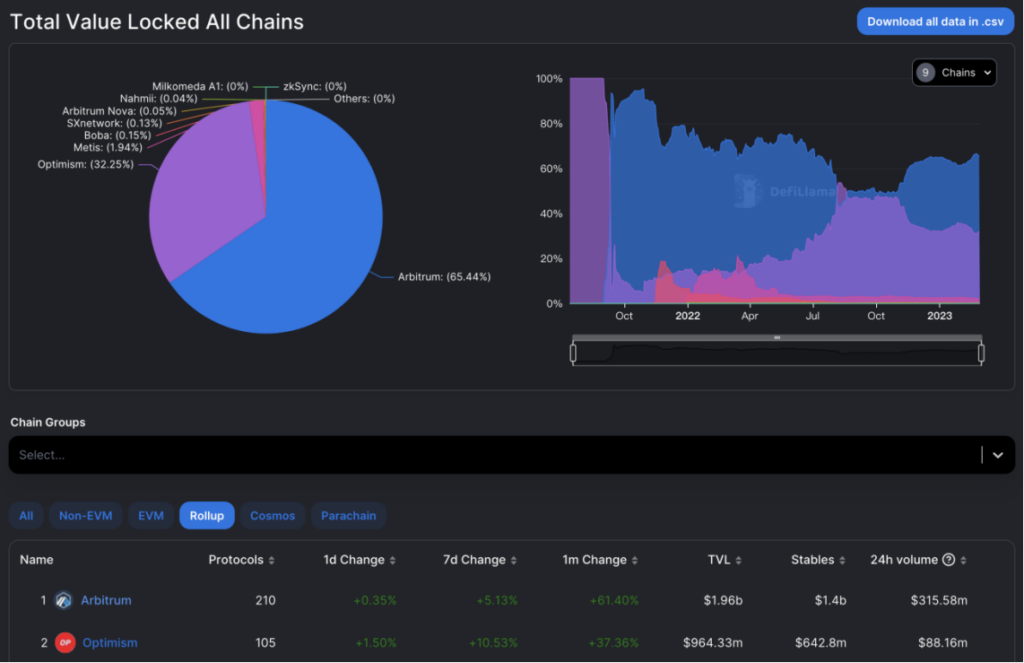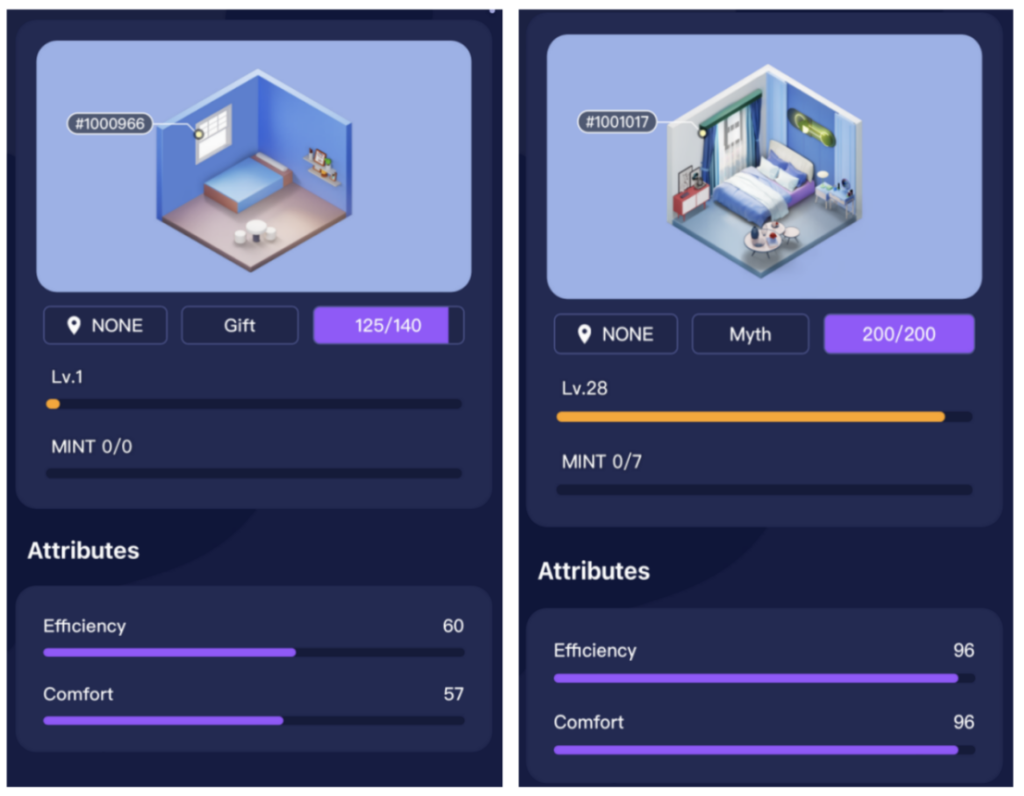As one of the core solutions to the congestion problem of the Ethereum network, Layer 2 is undoubtedly one of the hottest tracks in recent years. Among them, Arbitrum is a popular project in the Layer 2 track.
According to data from the DeFiLlama website, the current TVL of Arbitrum is close to 2 billion US dollars, ranking among the top in the L2 track, accounting for 65.44% of the Rollup series. Compared with its closest competitor Optimism, Arbitrum’s TVL is more than twice that of Optimism, and the number of protocols (or applications) in its ecosystem is also twice that of Optimism’s ecosystem.

Source:DeFiLlama
Moreover, unlike OP, which has recently hit a new price high, Arbitrum has not yet issued its governance token. With the expectation of token issuance, the community’s attention on Arbitrum remains high, and many are looking for potential projects in its ecosystem such as GMX.
GoSleep, which was recently launched on Arbitrum, is the first Web3 sleep application in the ecosystem. It introduces the concept of “Sleep to Earn” and is a product that combines GameFi, SocialFi, and HealthFi. The core gameplay is that users can earn sleep rewards by achieving their self-set sleep goals.
Background of the Sleep Economy Market
A web3 application that allows you to make money just by sleeping might sound exaggerated. However, the concept of “sleep economy” has already emerged in the web2 market. According to the World Health Organization’s previous data, about 27% of people worldwide have sleep problems, and the economic losses caused by insufficient sleep are also significant. Therefore, a large number of products targeting to improve users’ sleep have emerged in the sleep market. However, neither sleeping pills nor smart devices have external incentives to encourage users to fall asleep.
GoSleep is a Web 3.0 application focused on sleep health, launched based on this concept. It hopes to help users increase their sleep duration and improve their sleep quality through token incentives, guiding users to “sleep more and earn more” and develop healthy sleep habits.
What kind of spark can be generated when the “sleep economy” and token incentives in the blockchain world are combined?
The first sleep application in Web3, GoSleep
GoSleep adopts a solution that combines blockchain token incentive mechanism and sleep monitoring technology. It obtains users’ sleep data through Apple’s Health Data Center or Google’s Sleep API and analyzes the environment light, noise, device sensors, and other data of the user’s mobile phone during sleep to detect the quality of the user’s sleep.
When users first use the GoSleep app, they can receive a free room NFT. This NFT represents a virtual bedroom in the GoSleep application. With the room NFT, users can use GoSleep to monitor their sleep duration and quality and earn sleep token rewards every time they sleep. The token rewards that users can obtain are influenced by the following four factors:
1.User’s sleep goal matching degree: The higher the degree of matching between the user’s actual sleep situation and the set sleep goal, the more tokens the user can earn, based on matching data of the bedtime and wake-up time.
2.User’s sleep duration matching degree: GoSleep aims to encourage healthy sleep habits, and the world generally recognizes the daily sleep time as 7 to 9 hours. The closer the user’s actual sleep duration is to the recognized value, the higher the reward. The rewards will be lower when the user’s sleep duration is below the recognized value or longer than the recognized value.
3.Wearable hardware devices like iWatch: Wearable hardware devices such as iWatch or wristbands provide more accurate and detailed data. Users who wear hardware devices can receive additional rewards.
4.NFT attributes, rarity, and level: First of all, users need a room NFT to enter the “sleep to earn” mode. As a core asset, the level, attributes, and rarity of the NFT are directly related to the number of token rewards users can obtain. The higher the level and rarity of the NFT, the higher the token rewards users can obtain.
Attributes: All NFTs in the application have two random attributes: Efficiency and Comfort. Efficiency mainly affects the production of sleep tokens, while Comfort mainly affects the production of governance tokens.
Rarity: NFTs are divided into five rarities: Free, Common, Rare, Epic, and Legendary, based on scarcity. After the NFT is fully upgraded, users can switch to receiving governance tokens as rewards.
Level: All NFTs have the same initial level, and users can upgrade them by consuming sleep point tokens. The higher the level, the faster the production of sleep token rewards. However, the higher the level, the more sleep tokens need to be consumed to upgrade.
Durability: In addition, each NFT has durability, and each time users collect rewards, the durability of the current NFT will be reduced. When the durability reaches zero, the NFT can no longer be used to collect rewards, and users will need to consume tokens to repair it. The number of tokens needed to repair will increase with each repair until the maximum number of repairs is reached. Improving the NFT’s grade will increase the number of repairs that can be made.

Different types of NFTs show their rarity, level, and attributes (left: free NFT; right: high-quality NFT).
The NFTs in the application are divided into two types: Free and Premium. Free NFTs are obtained by users when they register and can only be used to earn simple sleep incentives and invite new players to join. In contrast, Premium NFTs have additional functions such as upgrading, combining with other NFTs, and repairing durability.
Furniture components: NFTs such as beds, desks, pillows, and sofas can be used as household items to decorate the room. Users can directly purchase NFTs such as pillows, sofas, and carpets from the trading market to decorate their rooms. The more exquisite the decoration, the higher the token rewards. Users can consume sleep tokens to draw furniture components (box), and there is a chance to draw rare furniture components, which can provide more rewards.
Not only “Sleep to Earn”, but also diversified income models
The entry barrier for GoSleep is very low, and any user can participate. The sources of income are also diverse. Since users can earn money by sleeping as long as they have a room NFT, the simplest and basic way to make money is to sleep.
After obtaining a free NFT, the user sets a sleep target, including duration, sleep time, and wake-up time; 2) GoSleep pulls the user’s sleep data, monitors the player’s actual sleep situation, the closer it is to the target set before, the higher the sleep income, otherwise the farther the sleep habits and goals are, the lower the income.

If you have played Stepn before, you may not be unfamiliar with GoSleep’s product. As shown in the above figure, the user sets a sleep goal of 1:30 am to 10 am the next morning, with a sleep time of 8.5 hours, and is expected to receive 6,372 tokens as a reward for completing the goal.
In addition to earning tokens through sleep, the product also includes an NFT trading market where users can freely buy and sell NFTs to earn profits. In the future, the team may open a leasing market, where smart contracts can be used to sign lease agreements, lowering the threshold for users to use higher-level NFTs.
GoSleep also proposes a leaderboard design that ranks users based on their sleep duration, income, and popularity. The leaderboard is updated once a week, and users who rank higher can receive additional token rewards.
The design of the leaderboard may greatly increase user stickiness within the application by using token rewards and rankings to encourage user activity and engagement, while also providing a good opportunity for users to make profits. The popularity value refers to the comments and likes from other users on the room, and the higher the interaction frequency, the higher the popularity value. The existence of the popularity value leaderboard fully embodies the Social aspect, and users who want to obtain high popularity values usually need to actively interact with others.

In the future, the project team will also launch more social gameplay, combining sleep health with social interaction. Users can invite family or friends to form their own sleep community, invite friends and loved ones to sleep together in their NFT rooms, and engage in social activities such as breeding NFTs.
GoSleep’s Tokenomics
A.Dual-token mechanism
GoSleep adopts a dual-token mechanism in its token economics model, consisting of the sleep incentive token NGT and the governance token ZZZ for the GoSleep ecosystem. NGT is an in-app token with unlimited total supply, which can be earned by users for completing sleep tasks on the GoSleep app. On the other hand, ZZZ is a governance token with a total supply of 600 million, used for governing the GoSleep ecosystem.

Initial distribution of governance token ZZZ
The initial allocation of governance token ZZZ is as follows:
1.45% allocated to Sleep to Earn, including ecosystem development, Staking rewards, Community Treasury (DAO), etc.;
2.12% allocated to private sale;
3.1% allocated to public sale;
4.20% allocated to the core team;
5.10% allocated to the foundation;
6.12% allocated to marketing.
B:Token Utility
Currently, the NGT token has the following uses within the app: 1) NFT upgrading; 2) NFT repairing; 3) opening NFT treasure chests; and 4) forging new NFTs.
The ZZZ governance token can be used for: 1) staking to gain governance voting rights and rewards; 2) consuming within the app, including for NFT upgrades, forging new NFTs, and staking to increase the chance of NFT upgrading; In the GoSleep app, users need to consume a certain amount of ZZZ and NGT tokens to forge new NFTs.
From the product design and gameplay of GoSleep to the dual-token system, the team has bound NFT assets and tokens within the ecosystem, increasing the consumption pathways of tokens within the ecosystem and achieving a positive feedback loop between NFTs and tokens.
GoSleep may open a new chapter of “x to earn”
GoSleep has just announced the completion of a $2 million financing round led by Foresight Ventures, with participation from CCC Capital, Amber Capital, SevenX Ventures, Kucoin Ventures, and other institutions.
The project will begin a new round of testing soon. As a web3 application focused on sleep health, GoSleep has the support of well-known investment institutions such as Foresight and has enough explosive potential in its narrative, which can truly achieve the “earning money while lying down” concept.
Compared to other “x to earn” projects in the market, the entry barrier for users to participate in GoSleep is extremely low, and does not require a high cost, only the completion of sleep tasks to earn money. As a web3 application that can cultivate healthy sleep habits and earn income easily, there will undoubtedly be many users willing to pay for it. Late-night web3 users are not uncommon in the industry, and they are not unfamiliar with this type of product. If earning money is as simple as having good sleep quality, why not give it a try? Moreover, the success story of Stepn and similar applications in the market has laid a solid foundation of user base for GoSleep, making it easier for players to accept it.
The product is about to begin a new round of testing. GoSleep, with its “earn while lying down” effect, low user participation threshold, and the expectation of coin issuance and airdrops, has many advantages, making it likely to become a popular application in the Arbitrum ecosystem and lead the new generation of “x to earn” models.



